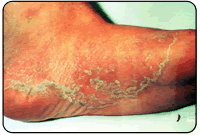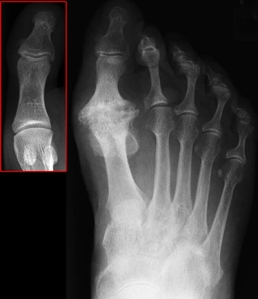Gout is caused by the accumulation of uric acid in the blood stream.
Symptoms include:
- Sudden, extreme pain associated with swelling
- Redness
- Increased warmth to the skin or joint
- Elevated temperature
- Normally occurs in the big toe or knee joint, but sometimes on the top of the foot, the heel and the ankle joint
You have a higher chance of getting gout if you:
- Consume alcohol and red meats regularly
- Frequently use Aspirin
- Take medication for high blood pressure
- Have had kidney damage
Gout occurs most frequently in men, and women will not get gout until after menopause (unless they have had a hysterectomy).
The onset of gout is often sudden and intense. The attacks can become recurrent, which may result in permanent damage to the affected joint over time.
Diagnosis:
Diagnosis often comes down the physician’s clinical experience. That being said, bloodwork may be taken and/or a sample from the joint may be analyzed.
Treatment:
Treatment normally combines medications for gout and for infection. It is useful to immobilize the foot with a removable cast for some period of time. Once medication is taken, the symptoms of gout will start to subside rapidly. If untreated, it may take several days for the gout attack to subside.
If you struggle with this condition, please call now for an immediate appointment: (706) 802-1800.
(For more information, see PodiatryNetwork.com.)



